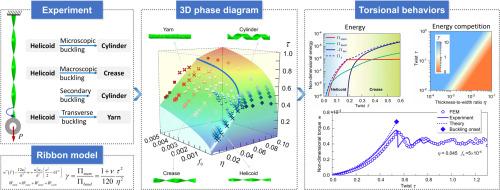扭转下拉伸带的力学和形态演变:三维相图
IF 7.1
1区 工程技术
Q1 ENGINEERING, MECHANICAL
International Journal of Mechanical Sciences
Pub Date : 2024-10-30
DOI:10.1016/j.ijmecsci.2024.109786
引用次数: 0
摘要
在自然和人工系统中,纤细结构都会发生复杂的形状变化。软带在受到载荷和几何约束时会表现出丰富的形态。宏观、微观和横向屈曲模式之间的竞争导致了多种形态转变,揭示了螺旋形、皱褶、圆筒形和卷曲纱线构型之间不同的演化路径。然而,张力、捻度和几何形状在决定扭转下拉伸带屈曲模式中的作用仍不清楚。在本研究中,我们通过实验、理论和有限元模拟全面研究了弹性带的扭转不稳定性。我们采用一维模型来描述螺旋阶段的非线性扭转响应。我们提出了描述折痕配置的建模方法,并在有限元分析的基础上得出了半解析解。我们发现,宏观屈曲模式和微观屈曲模式之间的竞争受厚度与宽度比的制约,而厚度与宽度比决定了螺旋体中膜应变能和弯曲应变能的相对大小。此外,随着外加张力的增加,屈曲模式会从纵向转向横向。通过构建与扭转、拉力和厚宽比相关的三维相图,可以确定弹性带的形态转变。这项研究对于理解形态的复杂性和实现对细长结构的精确控制具有重要意义。本文章由计算机程序翻译,如有差异,请以英文原文为准。

The mechanics and morphology evolutions in stretched ribbons under torsion: A 3D phase diagram
Slender structures ubiquitously undergo complex shape transformations in both natural and artificial systems. Soft ribbons can exhibit rich morphologies when subjected to loading and geometric constraints. The competition between the macroscopic, microscopic, and transverse buckling modes results in multiple morphological transitions, revealing distinct evolution paths among helicoid, crease, cylinder, and scrolled yarn configurations. However, the roles of tension, twist, and geometry in determining the buckling modes of a stretched ribbon under torsion remain unclear. In this study, we comprehensively investigate the torsional instabilities of elastic ribbons through experiments, theory, and finite element simulations. A one-dimensional model is employed to describe the nonlinear torsional responses in the helicoid stage. We present a modeling approach to describe the crease configuration and derive a semi-analytical solution based on the finite element analysis. We find that the competition between the macroscopic and microscopic buckling modes is governed by the thickness-to-width ratio, which determines the relative magnitudes of the membrane and bending strain energy in the helicoid. Additionally, as the applied tension increases, the buckling mode shifts from the longitudinal to the transverse direction. A three-dimensional phase diagram, as a function of twist, tension, and thickness-to-width ratio, is constructed to identify the morphology transitions of elastic ribbons. This study has implications for understanding the morphological complexity and achieving precise control of slender structures.
求助全文
通过发布文献求助,成功后即可免费获取论文全文。
去求助
来源期刊

International Journal of Mechanical Sciences
工程技术-工程:机械
CiteScore
12.80
自引率
17.80%
发文量
769
审稿时长
19 days
期刊介绍:
The International Journal of Mechanical Sciences (IJMS) serves as a global platform for the publication and dissemination of original research that contributes to a deeper scientific understanding of the fundamental disciplines within mechanical, civil, and material engineering.
The primary focus of IJMS is to showcase innovative and ground-breaking work that utilizes analytical and computational modeling techniques, such as Finite Element Method (FEM), Boundary Element Method (BEM), and mesh-free methods, among others. These modeling methods are applied to diverse fields including rigid-body mechanics (e.g., dynamics, vibration, stability), structural mechanics, metal forming, advanced materials (e.g., metals, composites, cellular, smart) behavior and applications, impact mechanics, strain localization, and other nonlinear effects (e.g., large deflections, plasticity, fracture).
Additionally, IJMS covers the realms of fluid mechanics (both external and internal flows), tribology, thermodynamics, and materials processing. These subjects collectively form the core of the journal's content.
In summary, IJMS provides a prestigious platform for researchers to present their original contributions, shedding light on analytical and computational modeling methods in various areas of mechanical engineering, as well as exploring the behavior and application of advanced materials, fluid mechanics, thermodynamics, and materials processing.
 求助内容:
求助内容: 应助结果提醒方式:
应助结果提醒方式:


